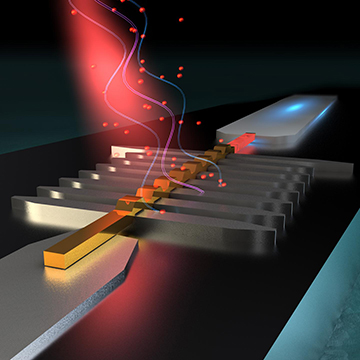
In the setup, a gold-palladium nanorod is tied to superconducting aluminum islands, to create a series of proximity-induced Josephson junctions. As a microwave pulse (blue) enters the nanorod, the transient heat increase as the pulse is absorbed flips the temperature of the nanorod from one metastable state to another. The abrupt temperature increase is transduced into a strong electric signal at the superconducting junctions, and is read out to detect the microwave pulse. [Image: Ella Maru Studio]
While techniques for single-photon detection have become increasingly common at optical frequencies, it’s a tougher proposition in the lower-energy microwave band. A team at Aalto University, Finland, has now moved the needle closer to practical microwave single-photon detection, with a new electronic platform that detects microwave photons through the heat they release on absorption (Phys. Rev. Lett., doi: 10.1103/PhysRevLett.117.030802).
The technique can detect pulses of as few as 200 microwave photons at a time. And the team believes that single-photon detection could be possible with some adjustments to the specifics of the setup.
Two detector options
The ability to detect single microwave photons has a number of applications both theoretical and practical, for example in certain types of quantum computing and experiments in quantum optics. But microwave detectors common in commercial applications (such as mobile phones) measure the amplitude of the electric field, rather than providing a count of individual photons.
In the quest to build a single-photon counter for the microwave band, two strategies are available. One is building a counter that measures a superconducting qubit excited by the incoming photon, but such an approach requires a close match between the qubit and the microwave frequency.
More practical, in the view of the Aalto team, are thermal detectors, which measure the temperature increase caused by absorbed photons, and which have found use for detecting increasingly long-wavelength photons in terahertz astronomy. But for microwave photons, the thermal approach, too, has an Achilles’ heel: given the energies involved (on the order of zeptojoules), the temperature spike caused by individual microwave photons is swamped by ambient thermal noise added when the signal is read out.
Building a better (thermal) detector
The Aalto team, led by Mikko Möttönen and the study’s first author, Joonas Govenius, set themselves the task of building a better thermal detector for microwave photons. The researchers began with a “microwave nanobolometer” that they had introduced in research published in 2014.

A micrograph of the microwave detector. [Image: Aalto University]
The device—“smaller than a single human blood cell,” according to a press release—consists of an electric circuit that includes a nanowire of a gold-palladium alloy that crosses a number of aluminum “islands” that become superconducting at near-absolute-zero temperatures. These short junctions act as Josephson sensors, providing a temperature-dependent induced electrical current that can be read out of the system.
A low-power probe pulse, fed into the system, raises the temperature of the Au-Pd nanostrip, which acts as a thermal mass, absorbing energy from the incoming pulse, and creating a base induced current. An incoming microwave pulse leads to a transient increase in the electron temperature in the system, which is transduced into an additional RF electrical spike by the electrothermal feedback from the Josephson junctions.
Making it bistable
But how does the system avoid the noise problem, and keep the weak microwave signal from being swamped by the background thermal noise? The Aalto team found that, by tweaking the probe pulse power and tuning its frequency to a level resonant with the circuit, the system could be made bistable—essentially, made to consist of two metastable electron temperature states.
In that bistable state, the system becomes a threshold detector that’s extremely sensitive to any tiny additional energy input, such as the increase from the microwave pulse. The arriving microwave pulse essentially “flips a switch,” making the system jump from a low to a high temperature state, and triggering an electrical signal that’s easily distinguished from the background noise.
With this system, the team was able to detect 8-GHz microwave pulses consisting of only 200 photons, and equivalent to 1.1 zeptojoules (1.1 × 10–21 J). That’s an improvement of an order of magnitude over previous results from thermal detectors, according to the team. And the study concludes that the scheme could ultimately enable single-photon detection through some technical improvements, such as reducing the volume of the Au-Pd nanowire and making the wire out of “a material with lower specific heat,” such as graphene.
